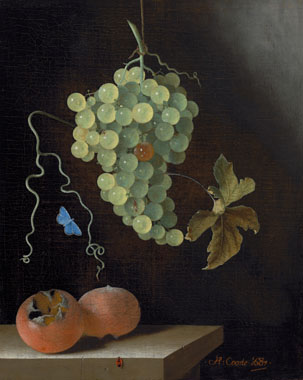Acquisition: Adriaen Coorte, "Still Life with a Hanging Bunch of Grapes, Two Medlars, and a Butterfly"

Adriaen Coorte’s (active c. 1683–1707) still-life paintings are among the most mysterious and compelling works of art produced in the Netherlands during the 17th century. The Gallery has just acquired Still Life with a Hanging Bunch of Grapes, Two Medlars, and a Butterfly (1687), a particularly striking work by the artist and one of only three known compositions in which the dominant element is suspended in midair before a dark background. This is the second painting by Coorte to enter the Gallery’s collection. A later work, Still Life with Asparagus and Red Currants (1696), was acquired in 2002.
Little is known of Coorte’s life or professional training, except that he evidently lived and worked in the Dutch city of Middelburg during the latter part of the 17th century. His 70 or so known paintings are dated from 1683 to 1707. The stark simplicity of his compositions—typically just a few natural objects set on the corner of a stone ledge or tabletop and silhouetted against a dark background—recalls the elegant restraint of paintings by Johannes Vermeer (1632–1675).
In this painting Coorte celebrates the bounty of autumnal fruits with a combination of grapes and medlars. The plump, juicy grapes dangling from a cord demonstrate a masterful use of light and shadow to render spherical objects, which is contrasted with thin, sharp highlights that describe the crisp, crinkled texture of the attached leaf. One of the painting’s most striking elements is the wiry, calligraphic grapevine silhouetted against the background, which seems to form a two-dimensional cage for the blue Polyommatus icarus hovering weightless in midair. Other tiny insects navigate the grapes and the stone ledge in the foreground of the painting. In the soft shadows of the ledge are two medlars, a popular fruit in the medieval and early modern periods. Medlars are picked with the fall’s frost but become edible only after they ripen off the tree, rendering the flesh soft and sweet. In Coorte’s time, they were one of the few fruits that could be eaten fresh in the winter.
Contact Information
General Information
For additional press information please call or send inquiries to:
Department of Communications
National Gallery of Art
2000 South Club Drive
Landover, MD 20785
phone: (202) 842-6353
e-mail: [email protected]
Chief of Communications
Anabeth Guthrie
phone: (202) 842-6804
e-mail: [email protected]
Newsletters
The National Gallery also offers a broad range of newsletters for various interests. Follow this link to view the complete list.